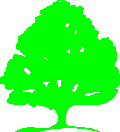
The Plant Life of Coombe Wood
Coombe Wood has had a long known history, and much of it is Ancient Woodland, whose existence dates back at least as far as the earliest published Maps of 1772–1774.
There are two important published sources of information on the wildlife of the wood. The first is the book by Oliver Rackham The Ancient Woodlands of England: The Woods of South-East Essex, published in 1986 by Rochford Borough Council. The second is the survey of Local Wildlife Sites in Essex by the Essex Wildlife Trust. Coombe Wood is listed there as CP10, and the document is available as a pdf file.
As an ancient woodland it has a wide diversity of plant life, rather more than would be expected from its size (according to Rackham). There are a number of species which are mainly confined to ancient woodlands, and are rarely seen in secondary woodlands.
For many of the plants listed below, there is a small i-symbol [If you hover over this with the mouse, then an information panel about that species will appear, usually with an image. i] before or after the name. If you hover over this with the mouse, then an information panel about that species will appear, usually with an image. Note, however, that the plain i-symbol [i] is purely a space-filler in lists and does not (yet) provide a link.
Vascular Plants
Vascular plants include the trees, flowers, grasses and ferns.
We have no records of Mosses or Liverworts though they are very common in the wood.
Records of these would be welcome!
Fungi are listed separately below.
The publications above list the following as typical plants of
Ancient Woodlands:
- [
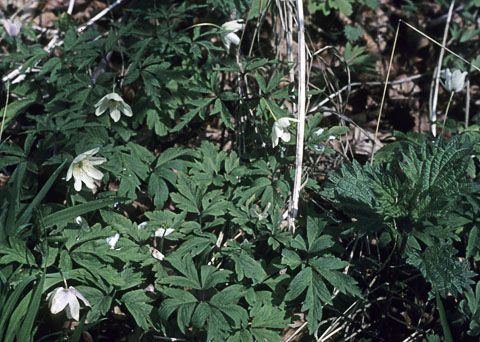 The Wood
Anemone is a common Spring flower, much in evidence before the trees develop
their leaves and create too much shade. The palmate leaves persist into the autumn.
The Wood
Anemone is a common Spring flower, much in evidence before the trees develop
their leaves and create too much shade. The palmate leaves persist into the autumn.
Photo by Gwyn Jordan. i] Wood Anemone (Anemone nemorosa), - [i] Spindle Tree (Euonymus eurpaeus),
- [
 Sanicle is a member of the Carrot family. The
palmate leaves are characteristic. i] Sanicle
(Sanicula europea),
Sanicle is a member of the Carrot family. The
palmate leaves are characteristic. i] Sanicle
(Sanicula europea), - [
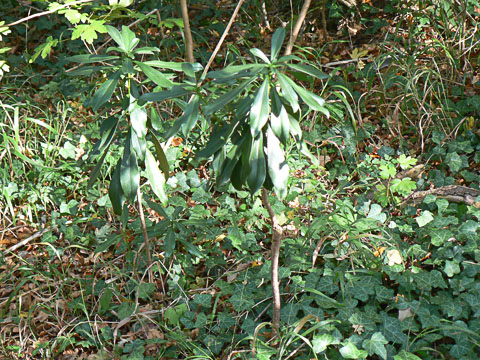 Spurge Laurel is typical of ancient woodlands
in the south-east. This evergreen shrub is unusual in that it flowers in the
late winter, from February to April. This photo was taken on 25th October
2011. This plant was actually within the secondary woodland in the south-east
corner, though it is fairly widespread throughout the wood.
i] Spurge Laurel (Daphne laureola),
Spurge Laurel is typical of ancient woodlands
in the south-east. This evergreen shrub is unusual in that it flowers in the
late winter, from February to April. This photo was taken on 25th October
2011. This plant was actually within the secondary woodland in the south-east
corner, though it is fairly widespread throughout the wood.
i] Spurge Laurel (Daphne laureola), - [
 Yellow Archangel
is very similar to the dead nettles, but the distinctive yellow flowers are
much in evidence in the late spring.i]
Yellow Archangel (Lamiastrum galeobdolon),
Yellow Archangel
is very similar to the dead nettles, but the distinctive yellow flowers are
much in evidence in the late spring.i]
Yellow Archangel (Lamiastrum galeobdolon), - [
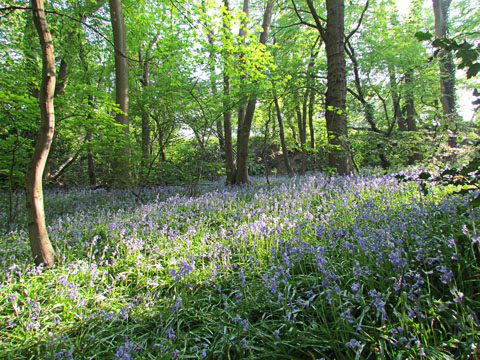 The carpet of blue, so characteristic of our woodlands in Spring, is largely
confined to English woodlands.
The carpet of blue, so characteristic of our woodlands in Spring, is largely
confined to English woodlands.
Photo by Gwyn Jordan. i] Bluebell (Hyacinthoides non-scripta), - [i] Hairy Wood-rush (Luzula pilosa),
- [
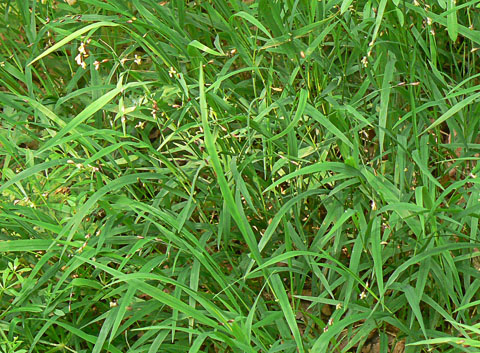 Wood Melick
is a typical woodland grass that is rarely found elsewhere. At this time of year, (early June) the
flowers are dark-coloured.i] Wood Melick (Melica uniflora) – a grass.
Wood Melick
is a typical woodland grass that is rarely found elsewhere. At this time of year, (early June) the
flowers are dark-coloured.i] Wood Melick (Melica uniflora) – a grass.
Other plants of note include:
- [
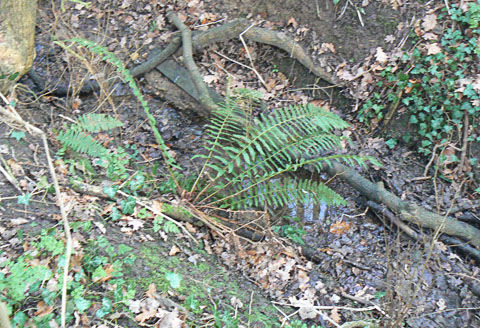 The
Soft Shield Fern is the only one of the wood’s ferns that remains green
overwinter. It is common along the banks of the streams
through the wood. i] Soft Shield Fern
(Polystichum setiferum).
The
Soft Shield Fern is the only one of the wood’s ferns that remains green
overwinter. It is common along the banks of the streams
through the wood. i] Soft Shield Fern
(Polystichum setiferum). - [
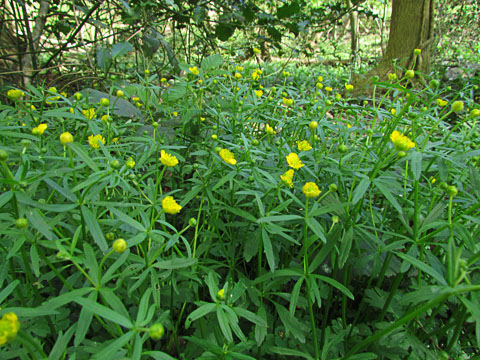 Goldilocks is a
species of buttercup, widespread in Britain, but scarce in south-east Essex. It has a tendency to lose the
odd petal giving the flower an asymmetric appearance.
Goldilocks is a
species of buttercup, widespread in Britain, but scarce in south-east Essex. It has a tendency to lose the
odd petal giving the flower an asymmetric appearance.
Photo by Gwyn Jordan. i]Goldilocks (Ranunculus auricomus). - [
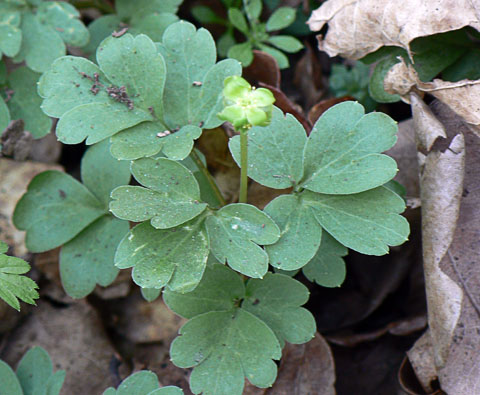 i] Moschatel or Town
Hall Clock (Adoxa moschatellina),
i] Moschatel or Town
Hall Clock (Adoxa moschatellina),
In addition to those species typical of ancient woodlands, there are also many other common woodland (and other) plants. These include:
- [
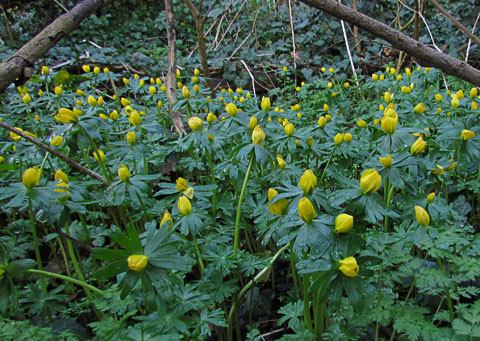 Winter Aconites in the north-western part of the wood, near the churchyard.
Winter Aconites in the north-western part of the wood, near the churchyard.
Photo by Gwyn Jordan, taken on 16th February 2011. i] Winter Aconite (Eranthis hyemalis), - [
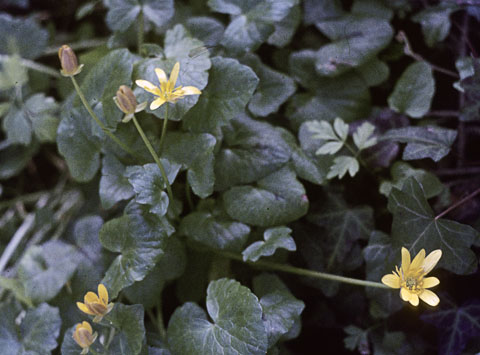 The Lesser Celandine is a welcome harbibger of spring, adding a splash of
yellow to the, otherwise drab, woodland floor. They are commonest around the
streamsides. i] Lesser Celandine
(Ranunculus ficaria),
The Lesser Celandine is a welcome harbibger of spring, adding a splash of
yellow to the, otherwise drab, woodland floor. They are commonest around the
streamsides. i] Lesser Celandine
(Ranunculus ficaria), - [
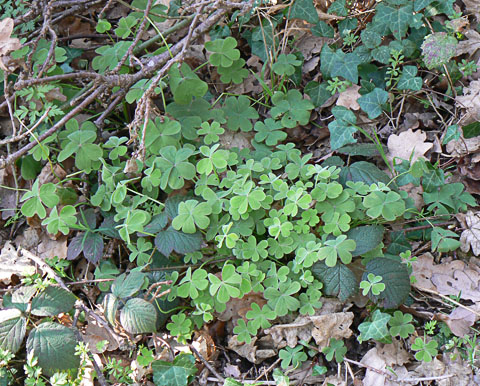 Wood Sorrel is thinly distributed in the wood. This plant
was near the main ride.i]
Wood Sorrel (Oxalis acetosella),
Wood Sorrel is thinly distributed in the wood. This plant
was near the main ride.i]
Wood Sorrel (Oxalis acetosella), - [
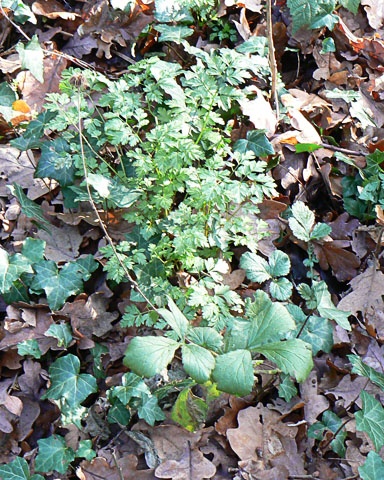 Despite the name, Wood Avens is found outside woods as
well, in hedgerows. The autumn stems with their burr-like seeds can persist
through the winter, as here. i] Wood Avens
(Geum urbanum),
Despite the name, Wood Avens is found outside woods as
well, in hedgerows. The autumn stems with their burr-like seeds can persist
through the winter, as here. i] Wood Avens
(Geum urbanum), - [
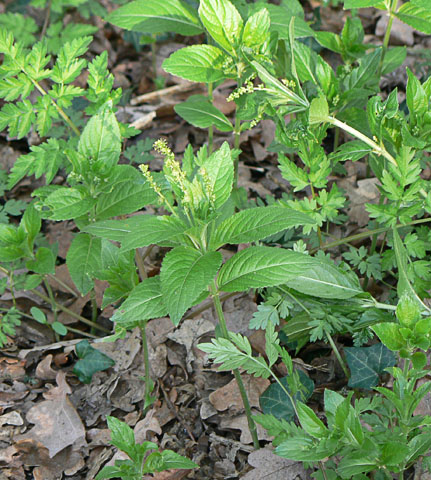
Dog’s Mercury has small green flowers. It grows in moderately shaded parts of the wood, and the plant may persist overwinter. i] Dog’s Mercury (Mercuralis perennis), - [
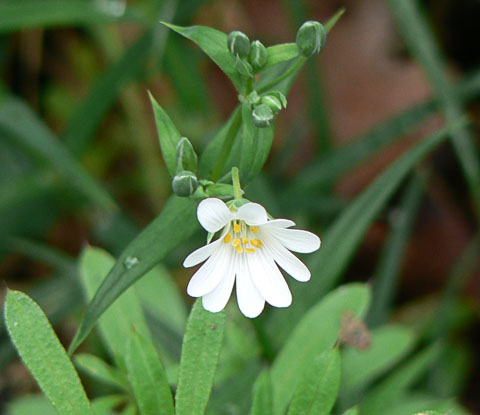 Greater Stitchwort is widespread in hedgerows and woodlands.
Note that the elongated leaeves in front of the flower are Goosegrass.
i]
Greater Stitchwort (Stellaria holostea),
Greater Stitchwort is widespread in hedgerows and woodlands.
Note that the elongated leaeves in front of the flower are Goosegrass.
i]
Greater Stitchwort (Stellaria holostea), - [
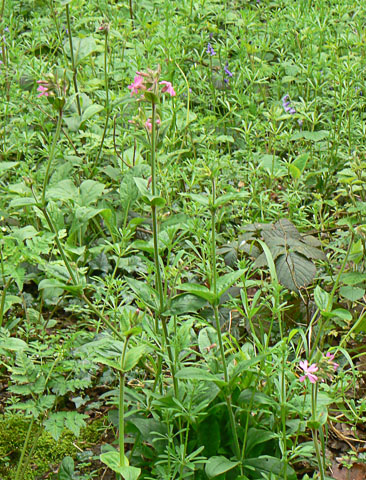 Red Campion is widespread in hedgerows and woodlands.
It can be found in flower throughout the year. i]
Red Campion (Silene dioica),
Red Campion is widespread in hedgerows and woodlands.
It can be found in flower throughout the year. i]
Red Campion (Silene dioica), - [i] Goosegrass (Galium aparine),
- [
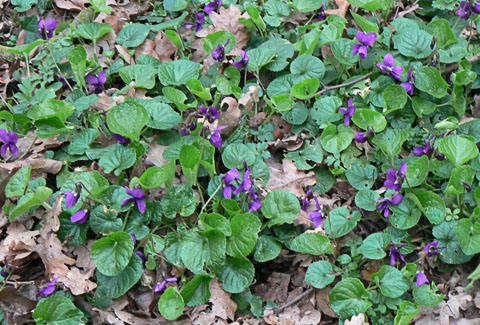 The Early Dog Violet flowers in March to May.
It differs from the Common Dog Violet (which flowers later) in having a
dark purple spur.i] Early Dog Violet
(Viola reichenbachiana),
The Early Dog Violet flowers in March to May.
It differs from the Common Dog Violet (which flowers later) in having a
dark purple spur.i] Early Dog Violet
(Viola reichenbachiana), - [
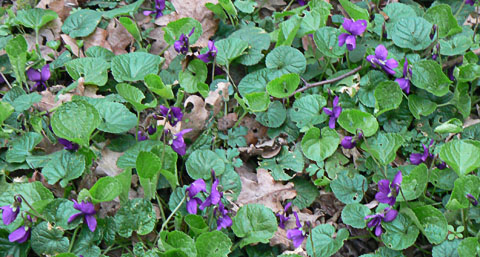 The Dog Violet flowers in May to June.
It differs from the Early Dog Violet (which flowers earlier) in having a
pale purple spur.i] Common Dog Violet
(Viola riviniana),
The Dog Violet flowers in May to June.
It differs from the Early Dog Violet (which flowers earlier) in having a
pale purple spur.i] Common Dog Violet
(Viola riviniana), - [i] Creeping Jenny (Lysimachia nummularia),
- [i] Enchanter’s Nightshade (Circaea lutetiana),
- [
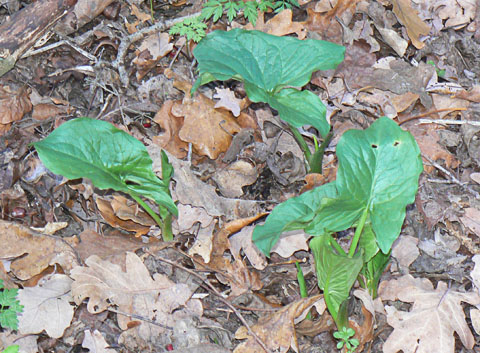 Wild
Arum is also known as Cuckoo-Pint or as Lords-and-Ladies. These broad arrow-shaped
leaves appear in early spring, and the sheathed flowers (known as a spathe)
appear in the summer. In the autumn, it produces red berries.
i] Wild Arum (Arum maculatum),
Wild
Arum is also known as Cuckoo-Pint or as Lords-and-Ladies. These broad arrow-shaped
leaves appear in early spring, and the sheathed flowers (known as a spathe)
appear in the summer. In the autumn, it produces red berries.
i] Wild Arum (Arum maculatum), - [
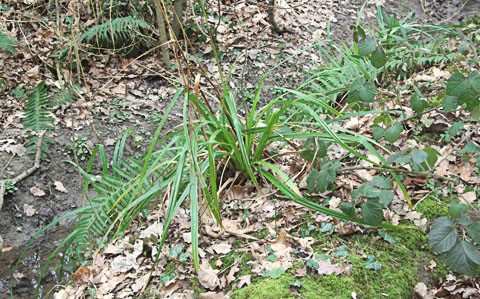 Pendulous Sedge grows along the streamsides,
especially along the main stream. It has long flowering stems that arch
downwards, hence the name. i] Pendulous Sedge
(Carex pendula).
Pendulous Sedge grows along the streamsides,
especially along the main stream. It has long flowering stems that arch
downwards, hence the name. i] Pendulous Sedge
(Carex pendula).
Some plants more typical outside woodlands include:
- [
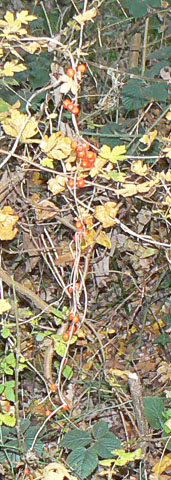 Black Bryony is a herbaceous climber widespread in hedgerows and woodlands.
The leaves are heart-shaped. In the autumn it produces these red berries.
This picture was taken on November 26th 2011i]
Black Bryony (Tamus communis),
Black Bryony is a herbaceous climber widespread in hedgerows and woodlands.
The leaves are heart-shaped. In the autumn it produces these red berries.
This picture was taken on November 26th 2011i]
Black Bryony (Tamus communis), - [
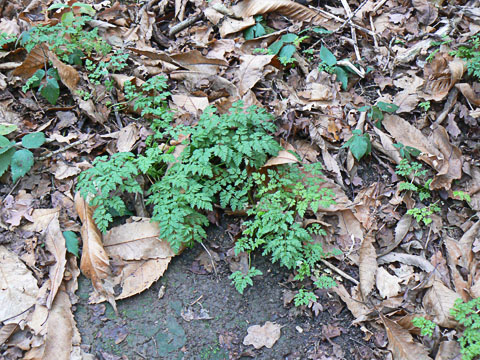 Cow
Parsley is one of our earliest spring plants to produce new green foliage.
In woods it grows where there is moderate light. i]
Cow Parsley (Anthriscus sylvestris),
Cow
Parsley is one of our earliest spring plants to produce new green foliage.
In woods it grows where there is moderate light. i]
Cow Parsley (Anthriscus sylvestris), - [
 i] Dogwood (Cornus sanguinea),
i] Dogwood (Cornus sanguinea), - [i] Hogweed (Heracleum sphondylum),
- [
 i] Broad-leaved Dock
(Rumex obtusifolius),
i] Broad-leaved Dock
(Rumex obtusifolius), - [
 i] Common Nettle
(Urtica dioica),
i] Common Nettle
(Urtica dioica), - [
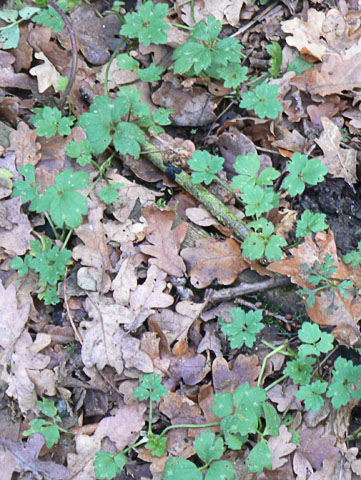 Creeping
Buttercup is typically a plant of meadows and other grasslands. It will
grow in the more open parts of woodlands. i]
Creeping Buttercup (Ranunculus acris),
Creeping
Buttercup is typically a plant of meadows and other grasslands. It will
grow in the more open parts of woodlands. i]
Creeping Buttercup (Ranunculus acris), - [
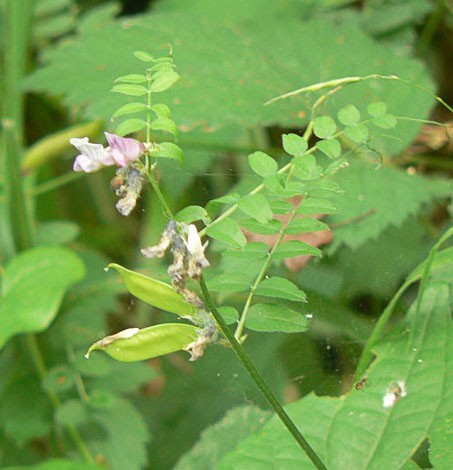 i] Common Vetch
(Vicia sativa),
i] Common Vetch
(Vicia sativa), - [
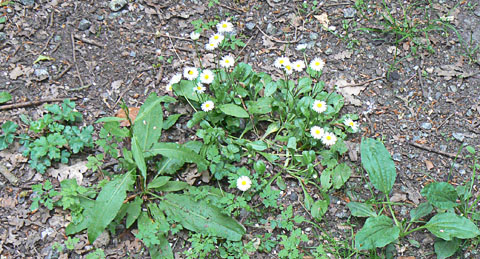 The
Daisy is more familiar as a plant of lawns. Here it is growing by the
main ride.i] Daisy (Bellis perennis),
The
Daisy is more familiar as a plant of lawns. Here it is growing by the
main ride.i] Daisy (Bellis perennis), - [
 The
plantain is on the right of the Daisy in this image. A wood is an unusual
location, plantains being more typical of grassy placesi]
Greater Plantain (Plantago major),
The
plantain is on the right of the Daisy in this image. A wood is an unusual
location, plantains being more typical of grassy placesi]
Greater Plantain (Plantago major), - [
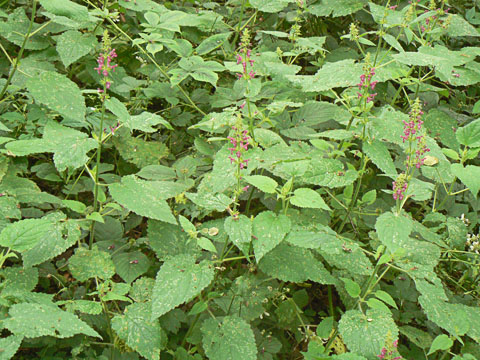 i] Hedge Woundwort
(Stachys sylvatica),
i] Hedge Woundwort
(Stachys sylvatica), - [
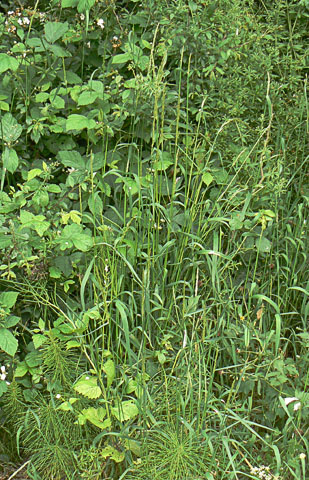 Tall
Oat-grass is a typical plant of meadows and waste ground, but is also
found in hedgerows such as here, by Rhoda Road North.i]
Tall Oat-grass Arrhenatherum elatius,
Tall
Oat-grass is a typical plant of meadows and waste ground, but is also
found in hedgerows such as here, by Rhoda Road North.i]
Tall Oat-grass Arrhenatherum elatius, - [
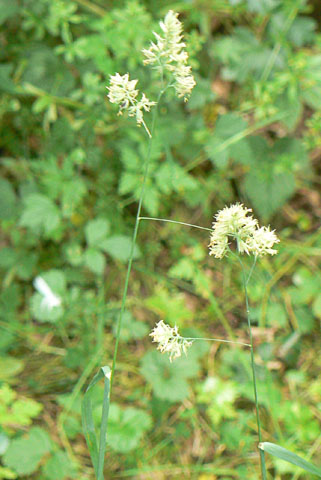 i] Cock’s foot
(Dactylis glomerata),
i] Cock’s foot
(Dactylis glomerata), - [
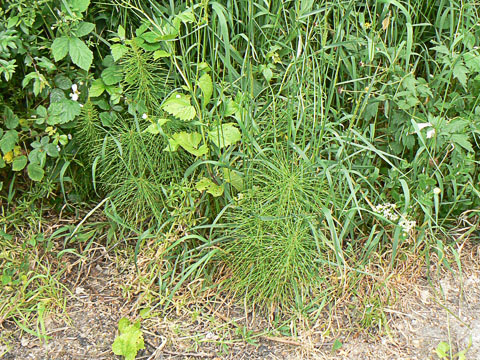 Horsetails
are commonly found in waste ground and roadsides, as here on the woodland
edge.i]
Horsetail (Equisetum sp).
Horsetails
are commonly found in waste ground and roadsides, as here on the woodland
edge.i]
Horsetail (Equisetum sp).
The trees of Coombe Wood are principally:
- [
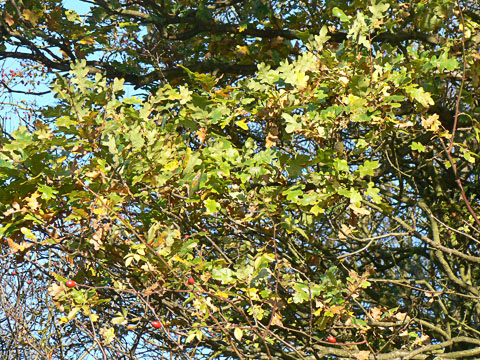 The
Common (or Pedunculate) Oak has very short leaf-stalks with a distinctively
lobed base to the leaf. The acorns are stalked, hence the alternative name.
The Common Oak is the dominant species on neutral and acidic soils such as
here. i] Pedunculate Oak (Quercus robor),
The
Common (or Pedunculate) Oak has very short leaf-stalks with a distinctively
lobed base to the leaf. The acorns are stalked, hence the alternative name.
The Common Oak is the dominant species on neutral and acidic soils such as
here. i] Pedunculate Oak (Quercus robor), - [
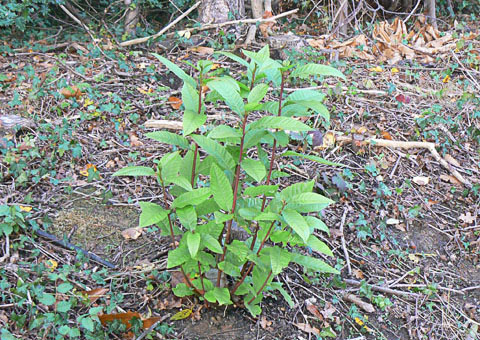 Sweet
(or Spanish) Chestnut is an long-introduced species which regenerates rapidly
when cut down. This is one of those felled by the side of the London Road
and has produced this bunch of shoots in one summer.
i] Sweet Chestnut (Castanea sativa),
Sweet
(or Spanish) Chestnut is an long-introduced species which regenerates rapidly
when cut down. This is one of those felled by the side of the London Road
and has produced this bunch of shoots in one summer.
i] Sweet Chestnut (Castanea sativa), - [
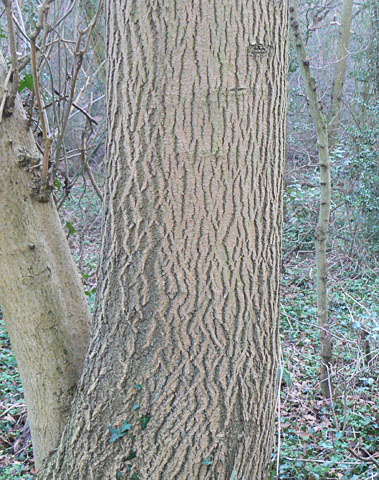 Ash leaves are readily distinguished by being pinnate,
with five to seven pairs of leaflets on each side. In the winter it can be
recognized by the large black buds which lie opposite each other along the
stem. The bole (lower trunk) has this distinctive mid-grey and grooved
appearance. i] Ash (Fraxinus exelsior),
Ash leaves are readily distinguished by being pinnate,
with five to seven pairs of leaflets on each side. In the winter it can be
recognized by the large black buds which lie opposite each other along the
stem. The bole (lower trunk) has this distinctive mid-grey and grooved
appearance. i] Ash (Fraxinus exelsior), - [
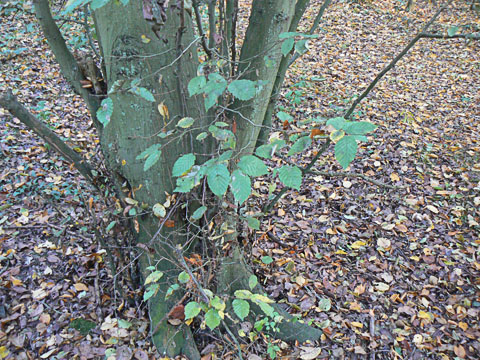 Hornbeam leaves are a soft, dull green with a
broadly serrated edge. The Trunk of hornbeam is unusual in that it is oval.
i] Hornbeam (Carpinus betulans),
much of which has been coppiced
[
Hornbeam leaves are a soft, dull green with a
broadly serrated edge. The Trunk of hornbeam is unusual in that it is oval.
i] Hornbeam (Carpinus betulans),
much of which has been coppiced
[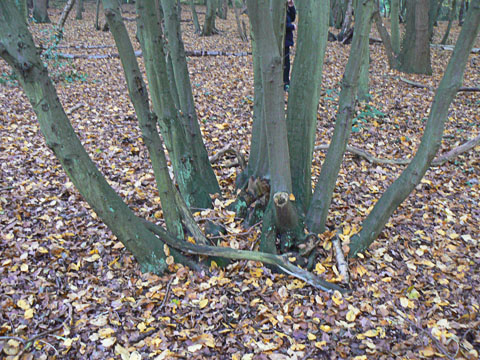 Hornbeam
was one of the principal trees for coppicing. After being cut down, the
stump regenerated, and after a number of years it could be cut down again.
After many cycles of this, the original tree becomes a stool – a ring
of trunks around a hollow space. i].
Hornbeam
was one of the principal trees for coppicing. After being cut down, the
stump regenerated, and after a number of years it could be cut down again.
After many cycles of this, the original tree becomes a stool – a ring
of trunks around a hollow space. i].
Other trees and shrubs, in smaller numbers, are:
- [
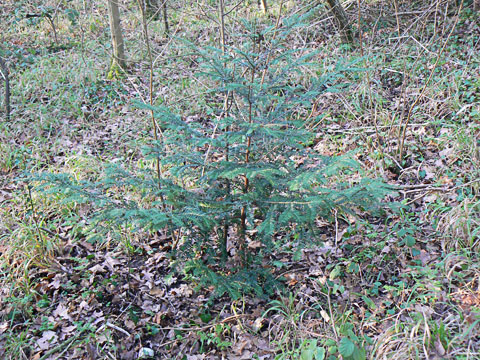 The yews in Coombe
Wood are all fairly young, no more than a metre or so high. They have probably
grown from seeds from the much older Yew trees in St Peter’s Churchyard
nearby. i] Yew (Taxus baccata),
The yews in Coombe
Wood are all fairly young, no more than a metre or so high. They have probably
grown from seeds from the much older Yew trees in St Peter’s Churchyard
nearby. i] Yew (Taxus baccata), - [
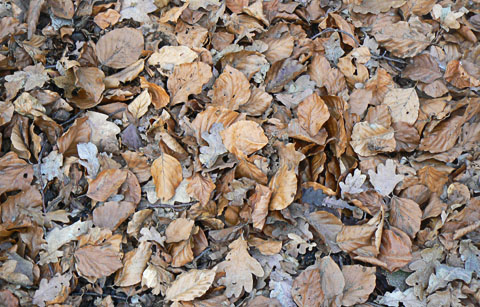 Beech is
common in the south-western parts of the wood where the woodland floor may
be carpeted with their rich red-brown leaves. i]
Beech (Fagus sylvatica),
Beech is
common in the south-western parts of the wood where the woodland floor may
be carpeted with their rich red-brown leaves. i]
Beech (Fagus sylvatica), - [
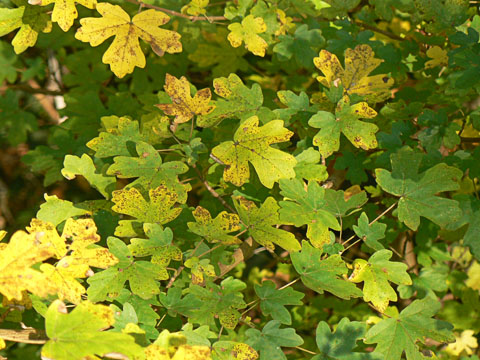 The
Field Maple is a common woodland shrub throughout Britain. It has characteristically
palmate (with radiating lobes) leaves that turn yellow then orange in the
autumn. i] Field Maple (Acer campestre),
The
Field Maple is a common woodland shrub throughout Britain. It has characteristically
palmate (with radiating lobes) leaves that turn yellow then orange in the
autumn. i] Field Maple (Acer campestre), - [
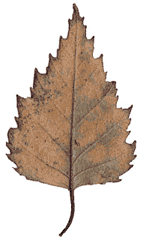
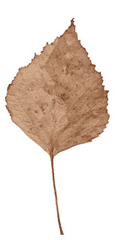 The Silver Birch occurs as an undershrub
in Coombe Wood, but there are also a few Downy Birch present. They can be
distinguished by the bases of the leaf. In the Silver birch (left), the leaf
base is approximately at right angles to the petiole (leaf stem). In the
Downy Birch (right), it joins at an angle. The leaf margins of the Silver
Birch tend to be more uneven and ragged-looking than those of the Downy Birch.
Note that these leaves are both shed autumn leaves. The twigs of the Silver
Birch are rough, whereas the young twigs of the Downy Birch are downy. The
main trunks of both species can be silvery, more so as they age.
The Silver Birch occurs as an undershrub
in Coombe Wood, but there are also a few Downy Birch present. They can be
distinguished by the bases of the leaf. In the Silver birch (left), the leaf
base is approximately at right angles to the petiole (leaf stem). In the
Downy Birch (right), it joins at an angle. The leaf margins of the Silver
Birch tend to be more uneven and ragged-looking than those of the Downy Birch.
Note that these leaves are both shed autumn leaves. The twigs of the Silver
Birch are rough, whereas the young twigs of the Downy Birch are downy. The
main trunks of both species can be silvery, more so as they age.
Birches do not live to a great age, and there are several dead trees in the wood, some fallen and some still erect. i] Birches (Betula pendula and Betula pubescens), - [
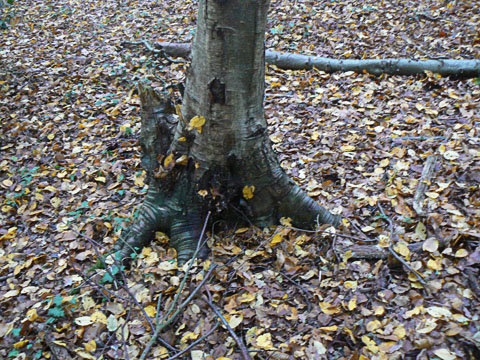 This Bole (lower trunk) of the Wild Cherry shows the characteristic horizontal
striations, and the reddish colouration of the bark.
i] Wild Cherry (Prunus avium),
This Bole (lower trunk) of the Wild Cherry shows the characteristic horizontal
striations, and the reddish colouration of the bark.
i] Wild Cherry (Prunus avium), - [
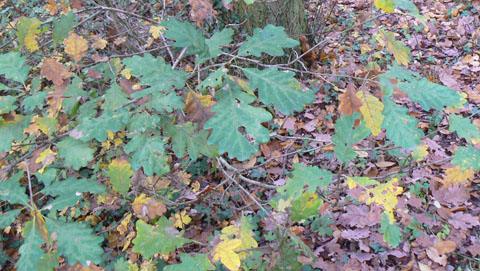 The Sessile (or Durmast) Oak is scarce within Coombe Wood. It is distinguishable
from the Common (or Pedunculate) Oak by the stalked leaves with a smooth
join between stalk and leaf. The acorn cups are sessile (without stalks).
i] Sessile Oak (Quercus petrea),
The Sessile (or Durmast) Oak is scarce within Coombe Wood. It is distinguishable
from the Common (or Pedunculate) Oak by the stalked leaves with a smooth
join between stalk and leaf. The acorn cups are sessile (without stalks).
i] Sessile Oak (Quercus petrea), - [
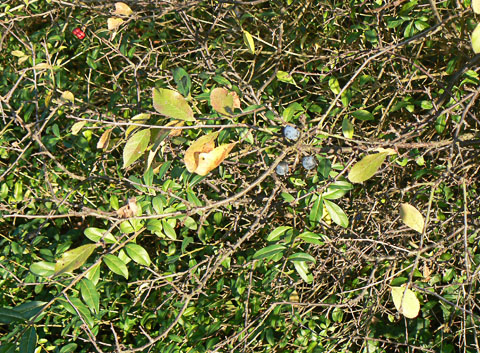 The Blackthorn is a common woodland
undershrub which often forms hedges on the borders of woods. The fruit, or
sloes, are much appreciated by birds. i]
Blackthorn (Prunus spinosa),
The Blackthorn is a common woodland
undershrub which often forms hedges on the borders of woods. The fruit, or
sloes, are much appreciated by birds. i]
Blackthorn (Prunus spinosa), - [The Common Hawthorn (also called May, because of the flowering time) is a common plant of hedgerows and woodland edges over most of Britain. The leaves are deeply lobed, both at the base and the tip. The fruit has just one seed and the flower has the one pistil (the central female part). i] Common Hawthorn (Crataegus monogyna),
- [
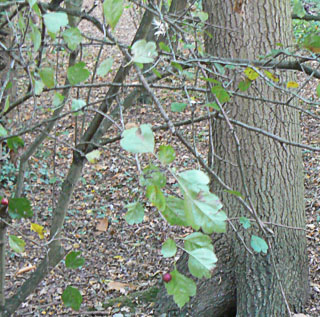 The Woodland Hawthorn (also called Midland
Hawthorn) is largely confined to ancient woodlands. It differs from the
Common Hawthorn in that the leaves are lobed only at the outer part, the
fruits bear two seeds and the flowers have two pistils (rather than the one
in the Common Hawthorn). i] Woodland Hawthorn
(Crataegus laevigata),
The Woodland Hawthorn (also called Midland
Hawthorn) is largely confined to ancient woodlands. It differs from the
Common Hawthorn in that the leaves are lobed only at the outer part, the
fruits bear two seeds and the flowers have two pistils (rather than the one
in the Common Hawthorn). i] Woodland Hawthorn
(Crataegus laevigata), - [
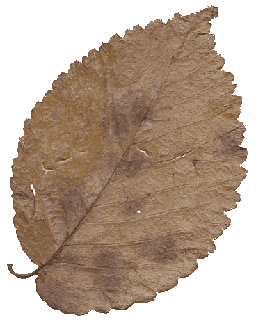 The Elms in Coombe Wood are clones of the English
Elm, Ulmus procera.
A clone comprises a group of trees all produced from one original by suckering — the
production of new above-ground shoots from the roots.
These shoots can be some distance from the parent, and can develop into quite
large trees which persist long after the original parent tree has succumbed
to Dutch Elm Disease. Elm leaves are distinctive, with an asymmetrical base.
One side has a large lobe which will often overlap the adjacent leaf stalk.
i] Elm (Ulmus procera),
The Elms in Coombe Wood are clones of the English
Elm, Ulmus procera.
A clone comprises a group of trees all produced from one original by suckering — the
production of new above-ground shoots from the roots.
These shoots can be some distance from the parent, and can develop into quite
large trees which persist long after the original parent tree has succumbed
to Dutch Elm Disease. Elm leaves are distinctive, with an asymmetrical base.
One side has a large lobe which will often overlap the adjacent leaf stalk.
i] Elm (Ulmus procera), - [
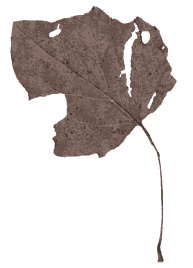 Rackham records that there is one clone of Grey
Poplar in the wood. Grey Poplar is a hybrid between Aspen (Populus
tremula), which does occur in Coombe Wood, and White Poplar (Populus
alba), which does not. Most Grey Poplars in the UK have been planted,
and this seems likely for the parent tree of this clone.
Rackham records that there is one clone of Grey
Poplar in the wood. Grey Poplar is a hybrid between Aspen (Populus
tremula), which does occur in Coombe Wood, and White Poplar (Populus
alba), which does not. Most Grey Poplars in the UK have been planted,
and this seems likely for the parent tree of this clone.
The living leaf has a pale grey underside (hence the name) and shares the flattened petiole (leaf stalk) of the Aspen parent. i] Grey Poplar (Populus canescens), - [
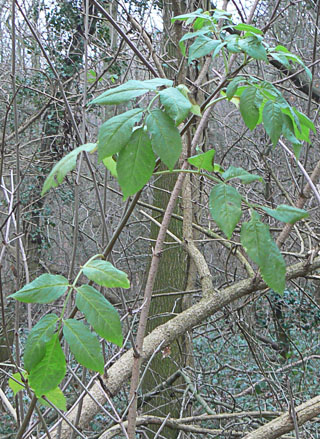 Elder is very common in hedgerows and woodlands
throughout Britain, never growing very large. The leaves are pinnate
with two to four leaflets on each side. Like the Ash, the buds and leaves
lie in opposite pairs along the twig but, in the Elder, the twigs are rough
(not smooth) and the buds are smaller and grey-green.
i] Elder (Sambucus nigra),
Elder is very common in hedgerows and woodlands
throughout Britain, never growing very large. The leaves are pinnate
with two to four leaflets on each side. Like the Ash, the buds and leaves
lie in opposite pairs along the twig but, in the Elder, the twigs are rough
(not smooth) and the buds are smaller and grey-green.
i] Elder (Sambucus nigra), - [
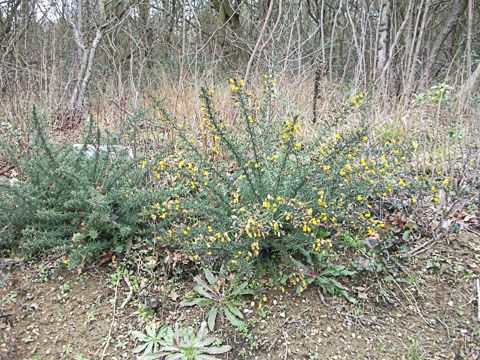 Gorse is a very spiny bush that grows in abundance along the southern
boundary of the wood, along the London Road, providing a splash of colour
from February on. i] Gorse
(Ulex europaeus),
Gorse is a very spiny bush that grows in abundance along the southern
boundary of the wood, along the London Road, providing a splash of colour
from February on. i] Gorse
(Ulex europaeus), - [
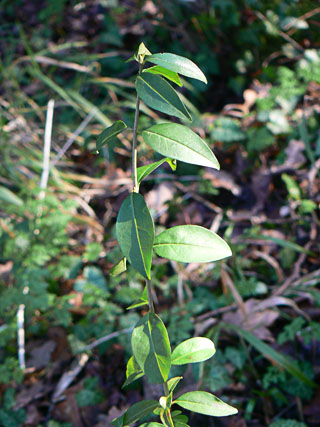 Wild Privet has longer, more pointed leaves than the cultivated species.
It occurs along the edges of the wood, especially near the churchyard and
along Rhoda Road North. i] Privet
(Ligustrum vulgare),
Wild Privet has longer, more pointed leaves than the cultivated species.
It occurs along the edges of the wood, especially near the churchyard and
along Rhoda Road North. i] Privet
(Ligustrum vulgare), - [
 i] Dog Rose
(Rosa canina),
i] Dog Rose
(Rosa canina), - [
 i] Hazel
(Corylus avellana),
i] Hazel
(Corylus avellana), - [i] Alder (Alnus glutinosa),
- [
 i] Apple
(Malus sylvaticus).
i] Apple
(Malus sylvaticus).
Woody climbers and scramblers include:
- [
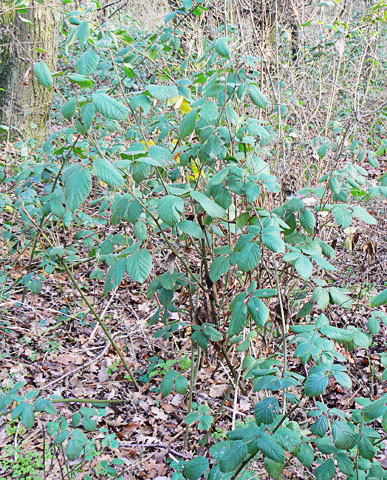 Bramble (or Blackberry, after the fruits) is
abundant throughout Britain in hedgerows. It occurs in woods whenever
there is sufficient light. However it does not flower and fruit unless
there is good light. i] Bramble
(Rubus fruticosus agg),
Bramble (or Blackberry, after the fruits) is
abundant throughout Britain in hedgerows. It occurs in woods whenever
there is sufficient light. However it does not flower and fruit unless
there is good light. i] Bramble
(Rubus fruticosus agg), - [
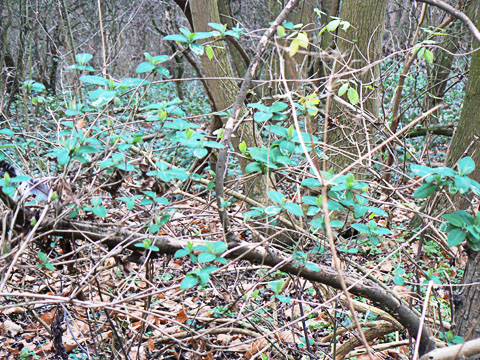 Honeysuckle is a woody climber common in
woodlands and hedgerows. It is common in Coombe Wood, though not abundant.
It is the food plant of the White Admiral Butterfly which has not been
recorded from Coombe Wood, though it has been spotted recently in one of the
Daws Heath woodlands. i]
Honeysuckle (Lonicera periclymenum),
Honeysuckle is a woody climber common in
woodlands and hedgerows. It is common in Coombe Wood, though not abundant.
It is the food plant of the White Admiral Butterfly which has not been
recorded from Coombe Wood, though it has been spotted recently in one of the
Daws Heath woodlands. i]
Honeysuckle (Lonicera periclymenum), - [
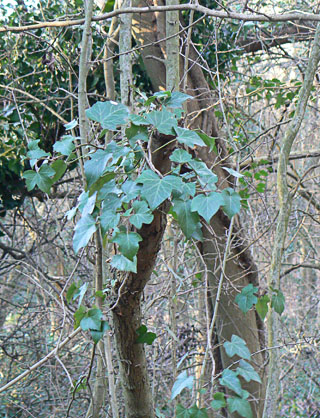 Ivy
grows abundantly throughout the wood. i] Ivy
(Hedera helix).
Ivy
grows abundantly throughout the wood. i] Ivy
(Hedera helix).
In addition to the native species, there are several naturalised alien trees and shrubs within the wood, largely seeded as escapes from gardens. The most noticeable of these are:
- [
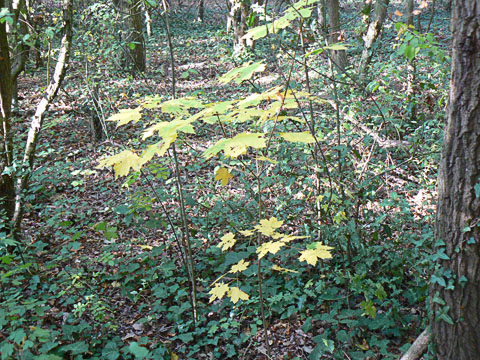 There are many seedlings and saplings of the Norway
Maple, but no mature trees. This probably reflects their more recent origin
from adjacent gardens and their inability to thrive in the shade of the
established trees. i] Norway Maple
(Acer platanoides),
There are many seedlings and saplings of the Norway
Maple, but no mature trees. This probably reflects their more recent origin
from adjacent gardens and their inability to thrive in the shade of the
established trees. i] Norway Maple
(Acer platanoides), - [
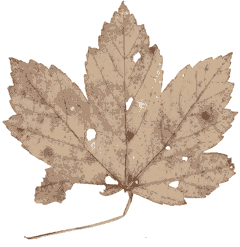 Sycamore is a long-established alien over much of
Britain. Although it is common locally, there are only a few in Coombe Wood.
The leaves have a distinctive palmate shape.
i] Sycamore (Acer pseudoplatanus),
Sycamore is a long-established alien over much of
Britain. Although it is common locally, there are only a few in Coombe Wood.
The leaves have a distinctive palmate shape.
i] Sycamore (Acer pseudoplatanus), - [
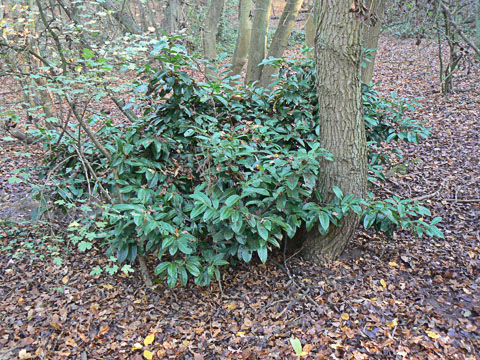 Cherry Laurel is an introduced
relative of the Blackthorn, but will tolerate shade. It has poisonous leaves
and fruit. i] Cherry Laurel
(Prunus cerasifera).
Cherry Laurel is an introduced
relative of the Blackthorn, but will tolerate shade. It has poisonous leaves
and fruit. i] Cherry Laurel
(Prunus cerasifera).
